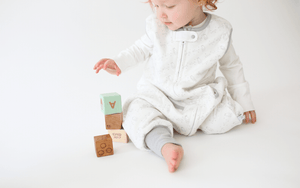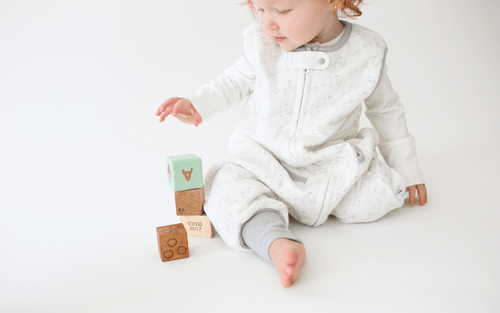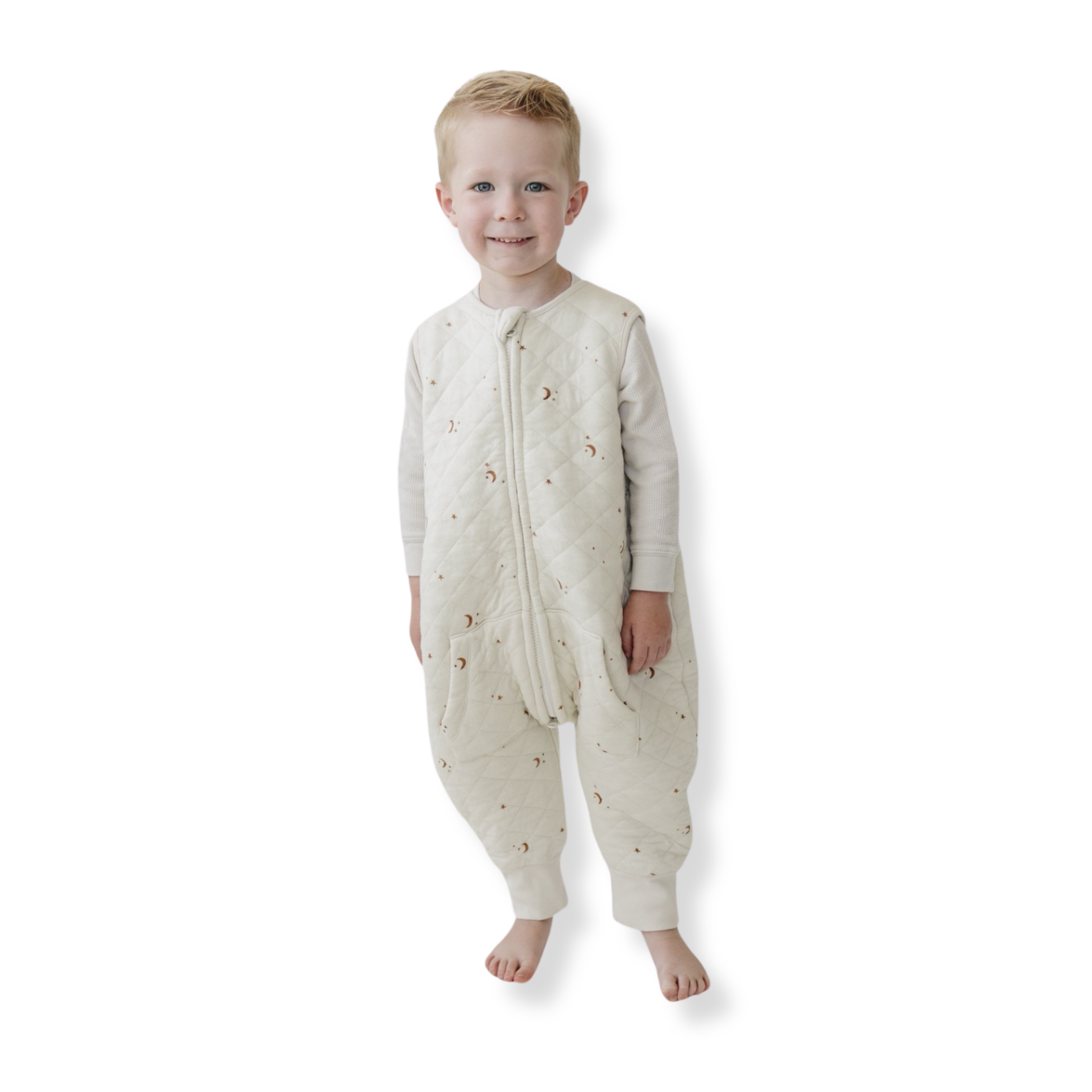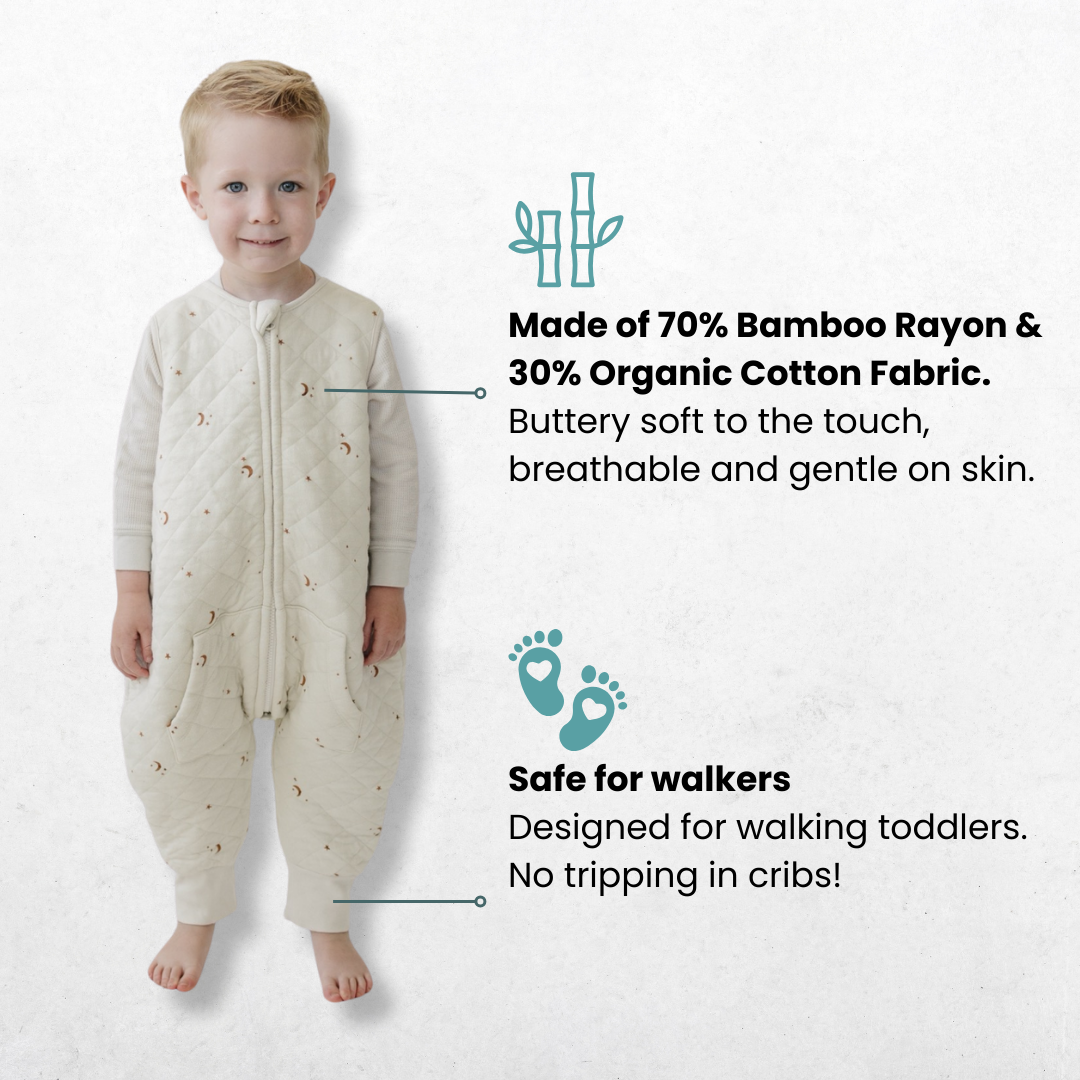Gentle Sleep Training

Are you thinking of ways to sleep train your baby so you can get good sleep yourself? If the thought of making your baby 'cry it out' scares you and hurts you, you might want to keep reading to learn about a gentle approach to sleep training your baby based on the baby's temperaments.
We asked sleep consultant Meredith Brough from Sweet Slumber who specializes in gentle sleep training methods to provide us her thoughts on how you can do this!
A Gentle Approach to Sleep Training Suited to Your Child’s Temperament
One of the common questions in the parenting world of sleep is “how do I get my child to self-soothe?” When children self-soothe or calm themselves, they become independent sleepers and sleep through the night in their cribs. But, if babies or toddlers have a hard time learning this skill, it can leave parents feeling burnt out and hopeless.
“Self-soothing” is the ability to calm oneself without assistance from another person. Sometimes self-soothing happens naturally. For example, when babies suck their thumbs or hands, they can often fall asleep and go back to sleep without parental assistance. Some parents quickly find that their children respond well to pacifiers or “loveys”, while other parents buy several items for months, only to throw in the towel. These are the babies and toddlers that get worked up and feel very upset when they are left alone in their beds, because they rely heavily on their parents to comfort and soothe them.
If your baby or toddler isn’t making progress in this area, there is nothing wrong. Your child is normal and is developing emotional regulation on time. Babies’ brains aren’t developed enough to calm themselves down for a few years. Most of the progress in this area occurs between 2-5 years old. That means a large number of children depend on their parents to calm them down, so, you are not alone! But, there is hope for your child, too.
Why do some babies relax and calm themselves naturally and sleep well so easily? There are babies who are born with an innate ability to relax and settle themselves. They aren’t taught this skill, it comes from inside; like an inner sense of security and peace. Babies like this have “textbook” or “angelic” temperaments, according to the author of “Secrets of the Baby Whisperer”, Tracy Hogg.
Babies and toddlers with personalities that are relaxed and laid back, naturally “go with the flow.” They are predictable and fuss only when they are hungry, tired or need their diapers changed. They can calm themselves quickly or with a little assistance from their parents, and may even be taught to fall asleep applying the “drowsy but awake” rule.
Relevant Read:
Online sleep advice and sleep books are geared towards helping “angelic” and “textbook” babies and toddlers. Since this description only fits a portion of children, a large number of parents get left in the dark, battling their children’s sleep problems alone.
It might be exciting to learn that children have other types of temperaments and traits, such as “sensitive,” “spirited,” and “grumpy.” I find that most children have a combination of temperament types. It’s important to identify their challenging traits to understand their needs. Even a few traits that are challenging will affect independence, the ability to self-soothe, and produce poor sleep habits. Some examples of challenging traits are: very physically attached, high energy, demanding, opinionated, fussy, sensitive, and intense. When there are several challenging traits present, babies and toddlers are categorized as “high needs” or “spirited” children.
Little ones with challenging traits and those who depend on their parents to soothe them, respond well to “thinking outside of the box” instead of traditional ideas.
The sleep consultant Meredith's creative approach develops strong sleep habits, permanently, for all types of children and babies. The methods are gentle and effective, so parents enjoy the process instead of dreading it.

1. Listen to your instincts/intuition always.
You know your child best and have intuition about what he or she needs. If you feel something will not work, or something is not right for you or your child, don’t do it. If you feel that your child needs you, respond and don’t worry about bad habits and messing things up. The process you are following and the skills you are building will cement these habits into lasting ones. Meeting your child’s needs means building security, forever.
At night, when children are going through regressions, acting fussy and not wanting to be put down, there is a reason. You are the main source of comfort, because your child cannot calm down alone (all children need to be comforted at times). When your baby or toddler struggles to sleep, it is almost always because of pain, discomfort, separation anxiety, or restlessness from developmental changes.
2. Conform the approach to your child’s temperament and needs.
Find methods that mesh well with the way that you are doing things now. You will understand what this looks like when you read #5. Worry about what works for your child and what he or she needs, and it will be right for both of you.
3. Offer comfort and reassurance.
Babies and toddlers who can’t regulate their emotions need their parents to do this for them. Identifying what helps your child relax and settle is an important step towards helping your child fall asleep on his or her own. Relaxing is what you want your child to do. Right now, your baby needs help through motion, being held in your arms, feeding, or having little to no contact (for sensitive temperaments).
Pay close attention to what brings comfort to your child while falling asleep. Some babies get worked up quickly because of their sensitivity, fussy dispositions, or FOMO. Do what will help him or her feel at ease going in the crib, so that you can progress!
4. Create a sense of trust and security. (One of the most important steps!)
Make sure that your child feels secure in the room and bed that is used for naps and bedtime. You will want your child to spend a lot of time there to create familiarity and peace. Teach your child to trust you! Make sure you respond when your child calls (or soon after). Teach him or her about object permanence to help with separation anxiety. Continue to build trust and security while you teach independent sleep skills.
5. Teach your child HOW to fall asleep.
The way that you have been helping your child slow down and fall asleep up to this point, has been facilitating sleep in every way. Babies and toddlers become very reliant on their mothers when it comes to falling asleep, so they sleep lightly, wake up as they change sleep cycles, and feel upset when they find that they are alone. They expect and demand your reassuring help to go back to sleep. When it comes to changing this dependency, putting little children down in bed, happy or not, is not enough to help them fall asleep. This is a huge problem. MOST of them need help figuring it out!
They need to learn HOW to fall asleep without rocking, holding, feeding, bouncing, driving, walking, etc., by slowly getting used to going in their beds, with your assistance and comfort, and keeping them calm. Later, they need to be weaned off all of the support, gradually. Here are some examples to get you thinking.
A. One gentle independent sleep method is to transition out of one crutch into the next and work towards falling asleep in the crib, one step at a time, changing your method every day or two. This can work for some mothers and babies, is worth a try, but takes patience. It can also be stressful. For example, if you are rocking, slow down first, then the next step is to stop rocking. Follow that by standing in place, and finally, lie your baby in the crib and pat him or her to sleep. This could take too many steps and you may get burnt out or your child may begin to fuss a lot at bedtime. It works best for textbook/angelic babies.
B. Modified “Pick Up/Put Down” Method by Tracy Hogg. This one works well for easy-going babies in its original format. But many babies may get overstimulated and upset and will not settle down, following the traditional way. Meredith's approach to this method is:
- Use this method for naps and bedtime. Lay your child in the crib. When he or she is not content in there anymore, pick up and hold him or her to settle. Lay your child back down. Use this plan for a few minutes for a couple of days to get your child used to it. After a few minutes, put your child to sleep the old way. If your child is not in the right mood, don’t push it. Stop. Listen to your instincts.
- Use the method for a few minutes longer every 1-2 days. Then, put your child to sleep the old way at the end of the process.
- Repeat, extending the time by 1-5 minutes every day or two, depending on how the child is handling it.
- As the process gets longer, your child will relax and learn to fall asleep in the crib. The old way of falling to sleep will be phased out.
This works for little ones who only calm when held (and fall asleep in your arms or feeding). It is a sensitive method, unless your child gets upset every time you lay him back in the crib. Progressing slowly could help a child like this. When your child is falling asleep on his or her own, walk out of the room often, coming back to comfort as needed. This will help you wean your baby off of your presence.
C. Lastly, the “Chair Method” by Kim West, can be effective for easy-going toddlers and babies, too. The way it is written is not effective for children who need to be held or touched to calm down, or if they are grumpy or sensitive and get worked up too quickly and intensely to be able to sleep. Some kids hate their cribs (implementing crib/bedroom playtime will make a big difference here). High energy toddlers won’t sit still or relax and fall asleep without being held. There are children who scream and cry because they can see their parents but they aren’t responding. To make this method effective...
- Do this method for naps and bedtime. Put the chair next to the bed instead of moving it gradually towards the door (do that part later, after your child is falling asleep in the crib). Offer reassurance through gentle patting, the weight of your hand, and closeness. Get up and calm your child in your arms and put him or her back into bed. Use your voice to shush and hum to invoke sleepiness. Limit the method to short periods that get longer every day or two, for example, Start at 5-10 minutes. If your child is not in the right mood, don’t push it. Stop. Listen to your instincts.
- Repeat this every day, and at appropriate times when your child is handling it well, add 3-5 minutes at a time. Go back to what's familiar at first, and when your child falls asleep doing this, he or she will eventually phase out the old way of going to sleep.
These are just a few ideas for building independent sleep skills, based on popular gentle methods. If these suggestions don’t work for your child after trying them for about a week or so, listen to your instincts and follow the guidelines to come up with a method of your own! I have seen many wonderful approaches to building sleep habits from mothers like you.
Consistency is important in making progress, but you don’t have to be perfect to successfully teach your child sleep habits. Do your best and be positive towards yourself and your child to move the process along smoothly. Depending on the temperament of the child, it usually takes 1-2 weeks to build security and trust (step #4), and 1-2 weeks to teach babies and toddlers to put themselves to sleep (step #5). It can take longer, especially if teething or mental leaps affect moods and cause separation anxiety. If this occurs, you may have to wait it out and try again later. Meeting your child’s needs during this time will continue to build security, and taking a break will prevent burnout and added stress for you.
When you form sleep habits by following this gentle and responsive approach, you will find that your child has learned to self-soothe. Babies, toddlers, and children can be taught strong sleep habits for a lifetime, applying these principles, no matter the rate of their emotional development, age, or temperament.






















